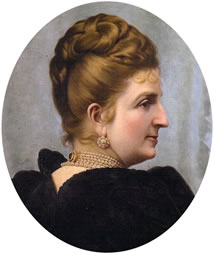Cultural circle of Queen Margaret

Rome was the capital of the Kingdom of Italy only from 1870 to 1946 and of the four kings and their queens only one was able to win the affection of the Italians, “Margaret”who was queen from January 1878 to July 1900 when the King Umberto was killed in Monza. Although Umberto the I was the second king of Italy, Margaret was the first Queen of Italy.
When the Quirinal Palace became the residence of the new king of Italy, Victor Emmanuel II did not bring you a queen because she had a morganatic wife, "Bela Rosin" who lived in Villa Mirafiori; indeed, the king lived little in the palace either because he loved hunting, or because in the evening he went out and reached the Countess of Mirafiori; the worldly life was little at the Royal Palace.
It changed everything when, after the death of Victor Emmanuel II, his son Umberto I became king; the young king was married to his cousin Margaret, daughter of the Duke of Genoa, beautiful and lively, who set up an agenda of activities that regularly took place at Quirinal Palace.
In particular in the climate of cultural renewal of a Rome no longer papal, if the Wednesday was the day of the week dedicated to parties and dancing, on Thursday artistic-literary meetings were held in the halls created for the ecclesiastical audiences. The most prominent exponents of Roman and Italian culture took part: D'Annunzio, Fogazzaro, Pascoli and Carducci who, after having met Queen Margaret, abandoned her republican faith for the monarchical one.
The young queen who loved culture and dabbled in music, surrounded herself with poets, intellectuals and artists who found to her a source of inspiration and a model of grace and elegance.
The cultural circle of Margaret of Savoy was open to enlightened minds without regard to the class and for this reason it was much appreciated by poets, artists and intellectuals. This cultural trend, which today could be defined “on the left”, certainly fed the collective imagination and made her one of the most beloved characters after the unification of Italy together with Garibaldi.
Famous intellectuals frequented her circle as Marco Minghetti, her trusty friend as well as twice President of the Italian Government, the historian Ferdinand Gregorovius, the philologist and forerunner of the journalists Ruggiero Bonghi, Emilio Broglio politician and journalist who entrusted to Alessandro Manzoni the Commission that decided on the language to be adopted after the unification of Italy, the baron archaeologist Giovanni Barraco whose private collection is today the Barraco Museum; the chamber music players and artists such as Giacomo Favretto and Michele Gordigiani around her, feeding the myth called "Margheritismo".
Minghetti was among the first visitors to the Queen's lounge in the afternoon and evening at Quirinal Palace and, also, when Margaret decided to learn Latin, to those visits were added almost daily morning lessons that had to help rise a deep friendship between the two, and that degree of intellectual confidence and intimacy of which is traced in the correspondence they had.
MInghetti died in 1886 and Queen Margaret so confessed her pain to a friend: "It still impossible seems that I should not see him in the morning, as I had been used to for several years, and it was a very sweet habit, because it is difficult to hear in a higher way without any pedantry and in a way that every word was a light for heart and for the mind ".
Margaret had been educated to music, listened to and made music and just as Minghetti was her Latin teacher, Giovanni Sgambati - who later founded the Conservatory of Santa Cecilia with her support - taught her music as well as other musicians of the time ...
Sign up and read the rest of the article!
by M.L. ©ALL RIGHTS RESERVED (Ed 1.0 - 06/01/2018)






